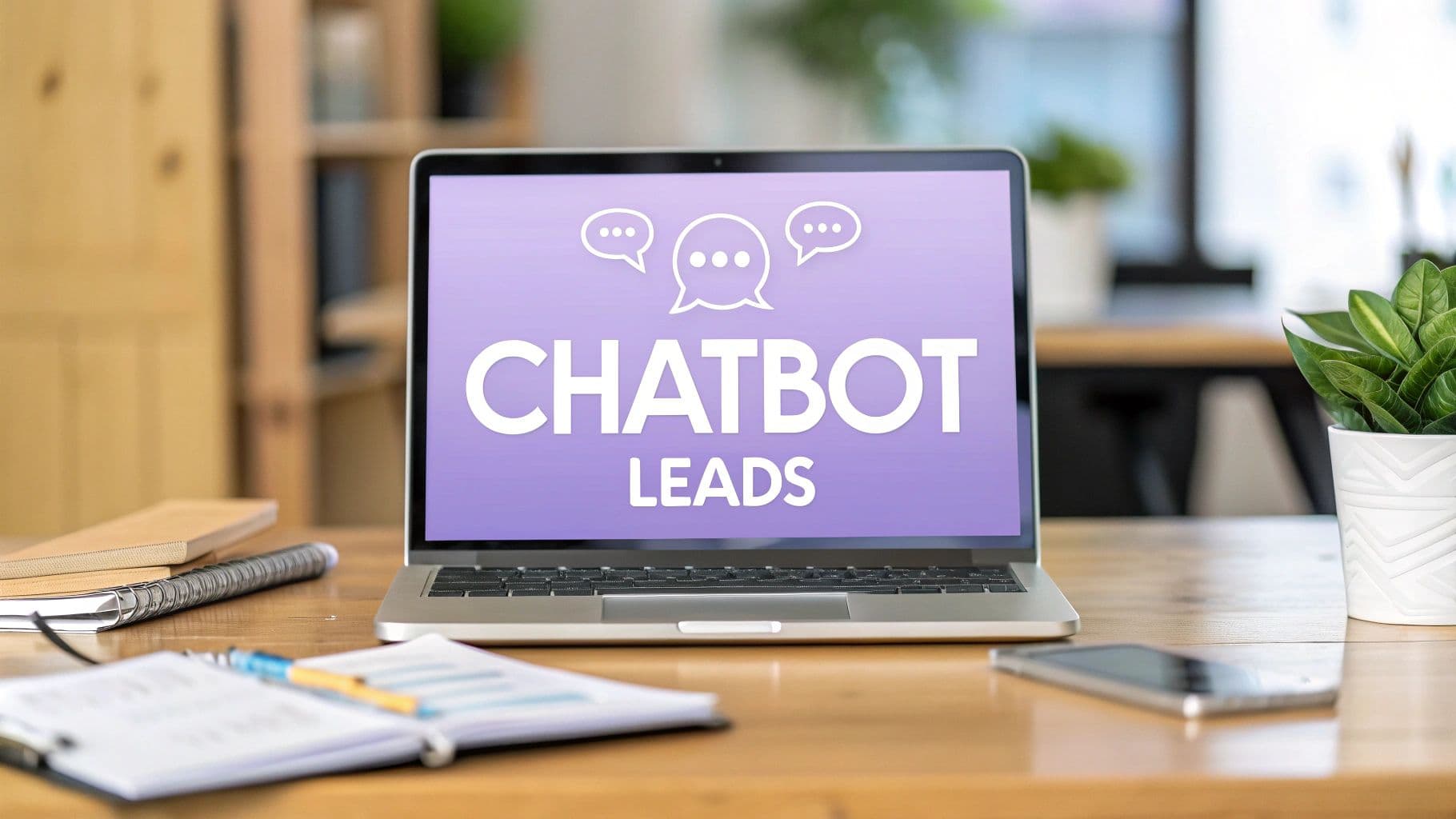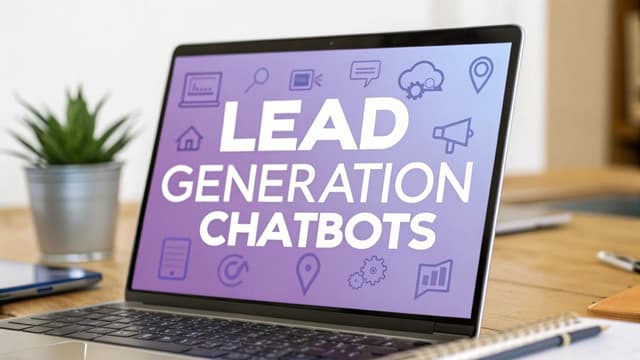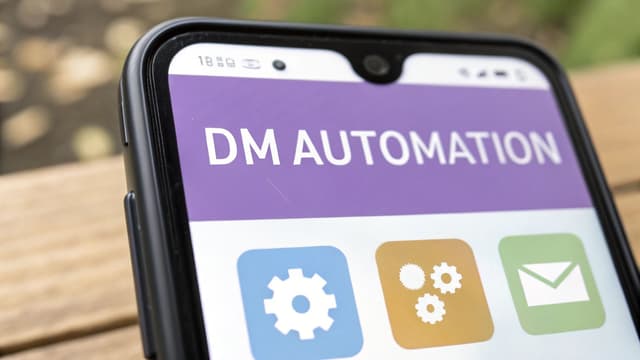The Rise of Conversational Lead Generation

Traditional lead generation methods, like static forms, are becoming less effective. Many potential customers find these forms tedious and abandon them before completion. This shift in user behavior demands a more engaging, interactive approach. That's where conversational lead generation, powered by chatbots, comes into play. Chatbots (including the ManyChat alternative) provide a dynamic, personalized experience, mimicking human interaction to capture and nurture leads more efficiently.
Why Chatbots Excel at Lead Generation
Chatbots are changing the game of lead capture by offering immediate engagement. Looking to get started? Try our free AI chatbot to jumpstart your lead generation. This real-time interaction is crucial for keeping a visitor's attention and significantly impacts conversion rates (boost conversions with chatbots). Rather than passively waiting for form completion, chatbots proactively engage visitors. They guide users through the process, answering questions as they arise.
This interactive approach creates a more positive user experience. It leads to increased engagement and a higher probability of conversion. Plus, chatbots offer 24/7 availability, ensuring no lead is missed due to time zones or off-hours inquiries.
This constant lead qualification process significantly reduces the time it takes to identify potential customers. It also allows sales teams to follow up promptly. This constant availability contributes to a lower cost-per-lead (Intercom chatbot pricing guide) by automating a critical part of the sales funnel.
The global chatbot market's rapid growth further validates the effectiveness of this technology. By 2025, the market is projected to reach $15.57 billion. This number is expected to climb to a remarkable $46.64 billion by 2029. This growth is driven by the increasing demand for automated customer service and improved operational efficiency. For more detailed statistics, check out this resource: Exploding Topics - Chatbot Statistics
Personalization and Value Delivery
Beyond simply collecting information, chatbots excel at providing value while gathering essential contact data. Using behavioral data, advanced chatbots personalize the user experience. They tailor conversations to each visitor’s unique interests and needs. This personalization creates a more natural interaction.
Chatbots can also offer immediate value to potential customers. They can provide instant answers to common questions, offer personalized product recommendations, or even schedule consultations or demos. This instant gratification builds rapport and positions your business as helpful and responsive.
This approach creates a win-win. Potential customers receive immediate value, and businesses gain valuable leads. The rise of conversational lead generation marks a shift toward a more user-centric and efficient approach to capturing and nurturing prospects.
Why Chatbots Are Revolutionizing Lead Capture
Traditional lead generation methods, like static forms and email campaigns, can often feel impersonal and time-consuming for potential customers. This can result in high bounce rates and missed opportunities. However, chatbots are changing this dynamic. They provide immediate engagement and create a more interactive, personalized experience. This shift is significantly improving lead capture and overall conversion rates.
The Power of Real-Time Engagement
This immediacy isn't just about convenience; it's about connecting with a visitor at the exact moment they show interest. Think of it like a retail store: a helpful sales associate is more effective than a passive sign-up sheet. Similarly, chatbots engage visitors at crucial moments, offering assistance and guidance. This proactive approach creates a positive user experience, leading to higher engagement and more valuable lead information.

The infographic above illustrates the improvements chatbots offer. This includes faster response times, increased lead capture, and higher conversion rates. The data shows that implementing chatbots can dramatically improve these key metrics, demonstrating tangible benefits.
24/7 Availability and Lead Qualification
A major advantage of chatbots is their 24/7 availability. Unlike traditional methods limited by business hours, chatbots can engage and qualify leads around the clock. Furthermore, leveraging a WhatsApp chatbot lead generation strategy enables businesses to reach audiences directly in their preferred messaging app. Read about the benefits of using AI chatbots for business growth. This ensures no opportunities are missed, regardless of time zones. This constant availability reduces the cost-per-lead. Automating this part of the sales funnel optimizes resources and improves efficiency. For a deeper look into chatbot lead qualification, check out this article: How Do Chatbots Qualify Leads?
Personalized Experiences and E-Commerce Success
Chatbots excel at creating personalized experiences at scale. Using behavioral data and past interactions, they tailor conversations to individual needs and interests. This creates a more natural and engaging experience, resulting in higher conversion rates as prospects feel understood. Learn more about how lead generation chatbots can boost business growth. Chatbots are particularly effective in e-commerce. In fact, 77% of the most successful lead generation chatbots are used by online retailers, highlighting their effectiveness in driving sales and improving customer service. Here are more detailed statistics on chatbot usage.
To further illustrate the differences, let's examine a comparison of chatbots against traditional methods.
The following table compares key performance metrics between chatbot-driven lead generation and traditional methods like forms and email campaigns.
| Metric | Chatbots | Traditional Forms | Email Campaigns |
|---|---|---|---|
| Availability | 24/7 | Limited by Business Hours | Dependent on Sending Schedule |
| Personalization | High | Low | Moderate (can be segmented) |
| Engagement | Interactive | Static | One-way |
| Response Time | Immediate | Delayed | Delayed |
| Lead Qualification | Automated & Real-time | Manual & Delayed | Based on Open & Click Rates |
| Cost-Per-Lead | Generally Lower | Moderate | Can be High (depending on campaign) |
As you can see, chatbots offer significant advantages in terms of availability, personalization, and real-time engagement. While traditional forms and email campaigns still have their place, chatbots offer a powerful way to improve lead capture and enhance the overall customer experience.
Crafting Conversations That Convert
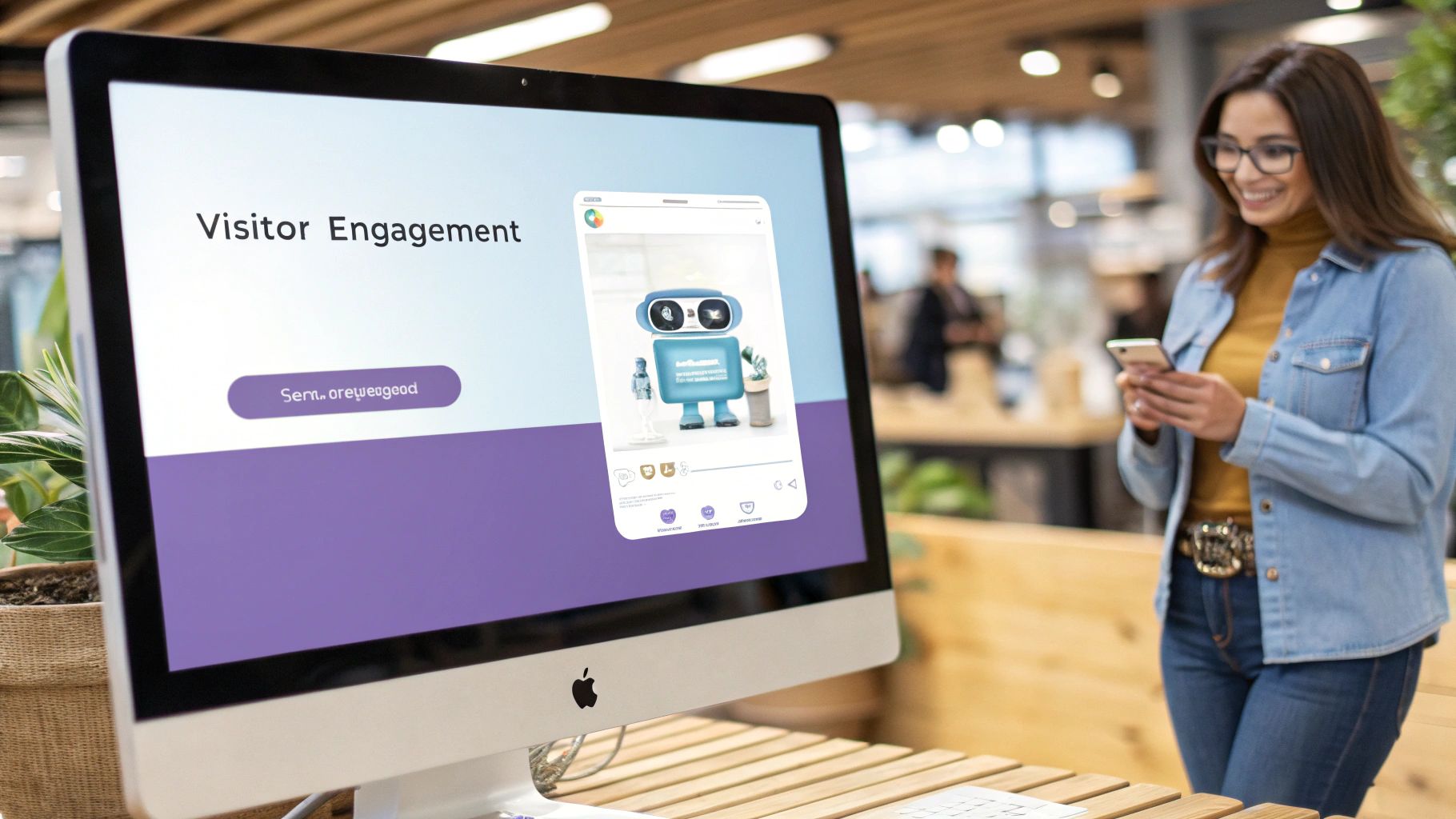
Creating a successful lead-generating chatbot isn't just about the tech. It's about understanding how people think and interact. This means building conversation flows that feel natural and engaging while strategically gathering important lead information. The aim is to create a chatbot experience that mirrors real human interaction, not a robotic Q&A session.
Building a Compelling Chatbot Personality
A key ingredient for effective chatbot conversations is a compelling bot personality. This personality should reflect your brand's voice and resonate with your target audience. Finding the right balance is key. The personality should be engaging without being overly familiar, and helpful without being intrusive. This helps avoid the "uncanny valley" effect, where a chatbot feels too artificial and puts users off. You might be interested in: How to master lead generation chatbots.
The Art of Progressive Profiling
Instead of overwhelming visitors with a long list of questions right away, successful chatbots use progressive profiling. This means gathering information bit by bit, over multiple interactions. For example, a chatbot might initially just ask for a name and email address. Then, in later visits or interactions, it can collect more details, like company size or job title. This approach often leads to higher completion rates because it's less intrusive and respects the user's time.
Mapping Conversation Paths for Maximum Impact
Well-designed chatbots use strategically mapped conversation paths. These paths anticipate user needs and respond intelligently to visitor signals and behavior patterns. This involves predicting different questions a visitor might ask and having relevant answers or resources ready. Chatbots can also tailor their responses based on past interactions or browsing history, creating a personalized experience.
Designing Engaging Opening Messages
First impressions matter. Opening messages should be carefully designed to grab attention and pull the visitor into a conversation. Effective opening messages are short, relevant to the page content, and offer a clear value proposition. For example, instead of a generic "Hello," a product page chatbot could ask, "Looking for more information on this product?" This focused approach is more likely to engage visitors and encourage interaction.
Questioning Techniques that Qualify and Convert
How a chatbot asks questions greatly affects its success. Instead of directly questioning visitors, the goal is to create a natural conversational flow. Open-ended questions, like "What brings you to our website today?" can reveal valuable insights and spark further discussion. By weaving qualifying questions smoothly into the conversation, chatbots can identify high-potential leads without disrupting the flow.
By concentrating on these key elements – personality, progressive profiling, conversation mapping, and smart questioning techniques – businesses can create conversations that truly convert, transforming casual website visitors into valuable leads.
Designing High-Converting Chatbot Experiences
Creating a chatbot that effectively generates leads requires careful design and optimization. It's not enough to simply have basic functionality; you need to focus on crafting a positive user experience. By studying real-world examples and understanding online user behavior, you can transform your chatbot into a powerful lead generation tool.
Crafting Engaging Opening Messages
First impressions matter. A well-crafted opening message can significantly influence user engagement. Analysis shows that the most effective opening messages are short, personalized, and directly related to the page content. Ditch the generic greetings and tailor your message to the visitor's current context.
For example, if a visitor is on your pricing page, the chatbot could ask, "Do you have any questions about our pricing plans?" This targeted approach instantly establishes relevance and encourages interaction.
Questioning Techniques for Qualification and Natural Conversation
Asking the right questions is crucial for qualifying leads without making the interaction feel robotic. Don't overwhelm visitors with a barrage of questions upfront. Instead, prioritize a natural conversational flow.
Use open-ended questions, such as, "What are your biggest challenges with [relevant topic]?" These questions can uncover valuable information and prompt further discussion. When designing conversations, consider current form design best practices. Subtly weave qualifying questions into the conversation to gather necessary data without disrupting the flow.
Personalization: The Key to Higher Conversion Rates
Personalization has a significant impact on chatbot performance. Businesses have seen 35-80% higher conversion rates by using dynamic content tailored to individual visitor behavior, referral source, and past interactions. Your chatbot should adapt its responses and offers based on what it knows about each visitor.
For instance, if a visitor has previously browsed a specific product category, the chatbot can offer relevant recommendations or product information. This personalized approach makes the interaction more valuable and increases the chance of conversion.
Measuring Success: Key Performance Metrics
Tracking the correct metrics is vital for evaluating and optimizing your chatbot's performance. Here’s a look at some key metrics to consider:
To help you understand these metrics and how to improve them, let's look at the following table:
Lead Generation Chatbot Performance Metrics: Key metrics to track when evaluating the effectiveness of your lead generation chatbot strategy
| Metric | Benchmark | Importance | How to Improve |
|---|---|---|---|
| Engagement Rate: The percentage of visitors who interact with the chatbot. | 10-20% | Shows how effectively the chatbot attracts visitor interaction. | Improve opening messages, chatbot visibility, and targeting. |
| Conversion Rate: The percentage of chatbot interactions that result in a lead capture. | 2-5% | Measures the chatbot's ability to turn interactions into tangible leads. | Optimize qualifying questions, lead capture forms, and calls to action. |
| Qualification Rate: The percentage of captured leads that meet your defined criteria. | 20-40% | Indicates the quality of leads generated by the chatbot. | Refine targeting and qualifying questions to attract ideal leads. |
| Drop-off Rate: The percentage of users who abandon the conversation before completing it. | <20% | Identifies areas for improvement in the conversation flow. | Analyze conversation logs, simplify questions, and offer alternative paths. |
This table provides benchmarks and improvement strategies for key chatbot metrics. By monitoring these metrics and adjusting your chatbot's design and conversation flow, you can continuously improve its lead generation performance. This data-driven approach helps ensure your chatbot remains a valuable marketing asset.
Seamless Marketing Ecosystem Integration
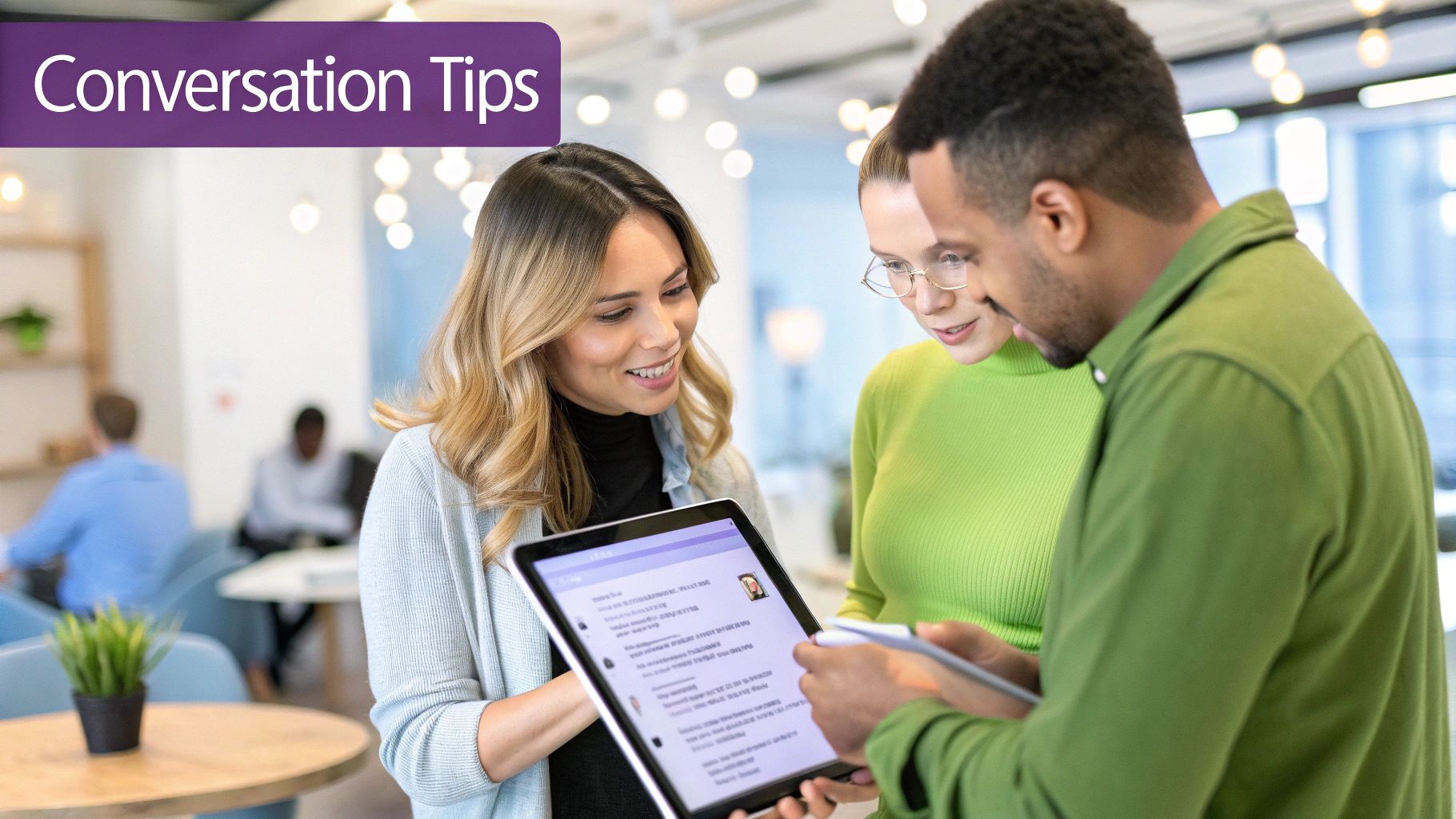
A chatbot working in isolation isn't living up to its full lead generation potential. Top companies understand this and integrate their chatbots directly into their existing marketing ecosystem. This creates a unified and streamlined system for capturing, qualifying, and nurturing leads.
This integration ensures a smooth transfer of information between platforms. It ensures that no leads slip through the cracks and that every interaction contributes to the overall marketing strategy.
Real-Time Data Flow Between Chatbot and CRM
One of the most important integrations is the connection between your lead generation chatbot and your Customer Relationship Management (CRM) system. This connection allows for real-time data flow. Qualified leads are instantly sent to sales teams, complete with the full conversation history.
For example, if a chatbot qualifies a lead based on specific criteria, this information, along with the entire chat transcript, is instantly pushed to the CRM. Sales teams can then follow up immediately with personalized messages, using valuable insights gained from the chatbot interaction.
This immediate access to lead information eliminates manual data entry and speeds up response times. This gives sales teams a significant advantage in converting warm leads. The real-time integration also provides a complete view of each lead's interaction history, enabling more personalized and effective follow-up communication.
Marketing Automation Integration for Advanced Follow-Up
Integrating your chatbot with marketing automation platforms unlocks powerful lead nurturing capabilities. Specific chatbot interactions and qualifying criteria can trigger advanced follow-up sequences.
For instance, if a lead expresses interest in a particular product, an automated email series can be triggered. This series could provide additional product information, customer testimonials, or special offers. This automated approach ensures consistent and timely follow-up, maximizing conversion rates.
This integration also personalizes follow-up messaging and offers based on information the chatbot gathers. This targeted approach improves the relevance of communications and strengthens the connection with potential customers.
Frictionless Handoff Between Bot and Human Agents
Chatbots excel at automating initial interactions, but sometimes a human touch is necessary. A smooth handoff between your chatbot and human agents is crucial for a positive customer experience. This transition should be seamless to ensure no leads are lost.
FlowGent AI is one example of a platform that facilitates this process. It allows chatbots to identify when human intervention is required and seamlessly transfer the conversation to a live agent.
This ensures a consistent and personalized experience for the lead, maintaining engagement and building trust. The human agent receives the full context from the chatbot interaction, empowering them to provide personalized and efficient assistance. This strategic blend of automation and human interaction optimizes lead management and builds strong customer relationships. This interconnected approach maximizes your chatbot’s lead generation potential, transforming it from a standalone tool into a key part of your overall marketing strategy.
From Theory to Practice: Real-World Success Stories
Real-world results are the best way to understand the power of chatbots for lead generation. This section explores how businesses have used chatbots to boost their lead generation, offering practical insights you can use immediately.
B2B Software: Increasing Qualified Leads
A B2B software company achieved a remarkable 347% increase in qualified leads after strategically incorporating conversational touchpoints within the customer journey. Their initial lead generation relied heavily on gated content and contact forms, creating a slow and frustrating experience. By implementing a chatbot, they instantly engaged visitors, answered questions proactively, and guided them toward relevant resources. This streamlined approach minimized friction, boosted engagement, and significantly increased qualified leads.
E-Commerce: Boosting Conversion Rates With Personalization
An e-commerce brand successfully utilized personalized product recommendation chatbots. They focused on gathering first-party data on customer preferences through the chatbot and using that data to deliver tailored product suggestions. This personalized approach resonated with their audience, leading to a 58% increase in conversion rates. The chatbot not only helped customers find products but also collected valuable data for refining marketing efforts. Learn more in our article about examples of chatbot conversations.
Professional Services: Reducing Cost-Per-Acquisition
A professional services firm reduced cost-per-acquisition by 41% while simultaneously increasing lead volume. They achieved this through conversation automation, focusing on early identification of ideal client profiles. The chatbot asked qualifying questions upfront, filtering out unqualified leads. This allowed the sales team to concentrate on the most promising prospects. This targeted approach saved time and resources while improving sales process efficiency.
Key Takeaways From These Success Stories
These examples demonstrate several key strategies for effective chatbot implementation:
- Strategic Placement: Position chatbots at key points in the customer journey for maximum engagement.
- Personalization: Gather data with chatbots to create personalized experiences that resonate with your target audience.
- Qualification: Use chatbots to qualify leads early, saving time and resources.
- Integration: Integrate your chatbot with current marketing automation and CRM systems for streamlined lead management.
By using these strategies, businesses across various industries can unlock the full potential of chatbots for lead generation, improving lead quality, conversion rates, and overall marketing ROI.
Ready to improve your lead generation with AI? Visit FlowGent AI to learn how our no-code platform helps you build and deploy intelligent chatbots that deliver results.
